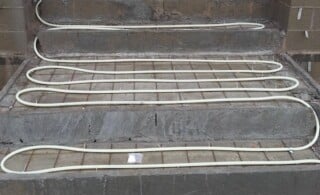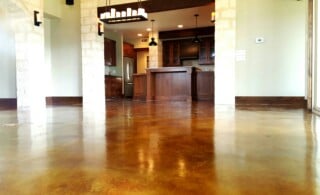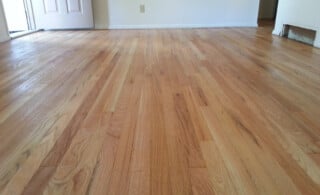
One of the great things about being home is that you can kick off your shoes and relax. You want to be comfortable, but you can only enjoy the comfort of going shoeless when your floors are at a reasonably warm temperature. There are many ways to create warm floors. Radiant floors are the most noticeably consistent choice, but basement ceiling insulation and even some well-placed rugs might do the trick. Whatever you choose, keep in mind warm floors are about more than just warming your feet. Warm feet means the room air temperature doesn’t need to be nearly as high. It will prevent a stuffy feeling in your rooms and save on energy costs.
Radiant Flooring
Radiant flooring can actually heat your whole house. By installing a heating system under your floor, it will not only create warm floors, but heat will radiate to the walls and air above the floor. Electric cabling or water tubes (hydronic heating) are the most popular forms of radiant flooring. With an inherently cool surface, tiling is the surface most homeowners feel has the greatest need for a subsurface heating system, but radiant flooring can work under any floor.
Installing a system for warm flooring probably isn’t as expensive as you think. Under the right conditions, it may cost you no more than a couple hundred dollars. Installation will be cheaper if you’re bringing a warm flooring system to a floor under new construction or remodeling. Even if you’re working with an existing floor, you may not need to remove the floor for installation if you have crawlspace underneath the floor.
Ready to start your heated flooring?
Find ProsBasement Ceiling Insulation
It’s not uncommon for basements to chill the floors on top of them. Maybe your warm flooring is best dealt with, not by heating them, but by preventing heat loss. In many situations, ceiling insulation can be a less expensive alternative to an entire heating system. This solution is best only for homeowners who don’t spend a lot of time in their drafty basements. Preventing heat loss from your floor is probably going to make your basement even colder. If you do spend a lot of time in your basement and think a cold basement may be the source of your cold floors upstairs, consider insulating your basement walls instead. This will keep your basement warmer and should, in turn, create warm floors upstairs.
Rugs
If neither radiant flooring nor basement insulation is a viable option for you, rugs may be your best bet. Rugs work well for smaller floors. Bathroom flooring is usually tile and is frequently the coldest floor in the house. Remember the smaller the floor the cheaper an installation such as radiant flooring will be, but throwing down some rugs or plush mats may be sufficient to do the trick.
 Radiant Floor Heating – How it Works & Benefits
Radiant Floor Heating – How it Works & Benefits  Concrete Flooring – Solid as a Rock
Concrete Flooring – Solid as a Rock  Whole House Humidifiers
Whole House Humidifiers  Cleaning Hardwood Floors
Cleaning Hardwood Floors  Choosing Green: Boilers and Radiator Heating Systems
Choosing Green: Boilers and Radiator Heating Systems 

Are You Familiar With This Topic? Share Your Experience.